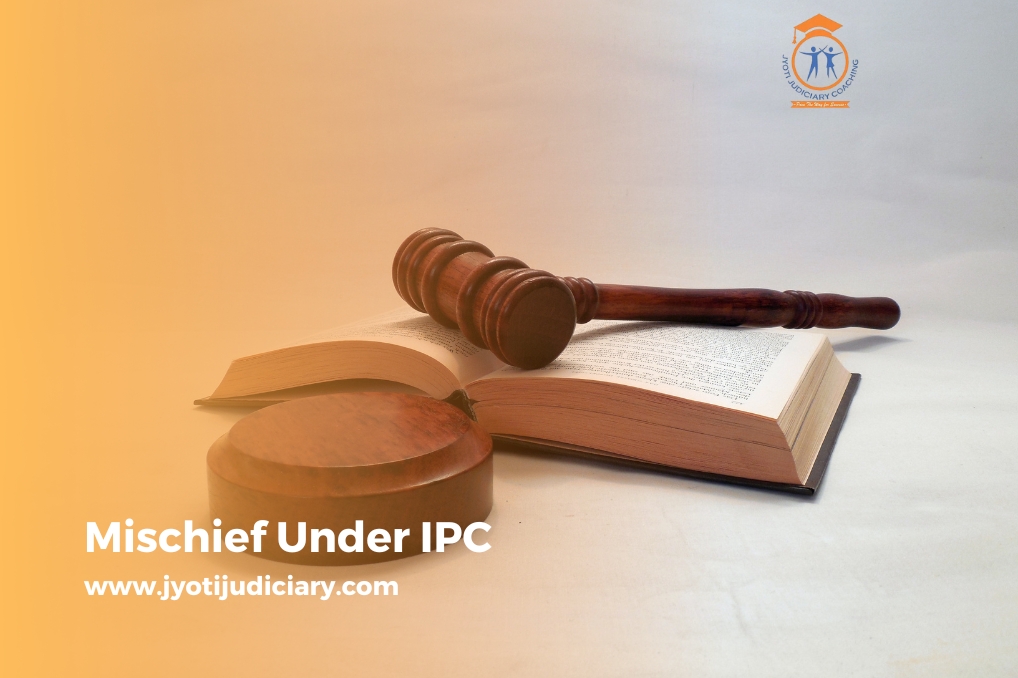
In accordance with the Indian Penal Code (IPC), mischief is a crime that frequently stimulates the interest of both laypeople and legal professionals. It covers an extensive range of behaviors, from somewhat mischievous to severely criminal offenses. Mischief is defined as any deliberate act performed with the purpose of inflicting property damage or any other kind of unjust gain or loss according to Section 425 of the IPC. But an in-depth examination is necessary given the nuanced nature of Criminal Mischief Law, its legal theories, and its societal implications.
Mischief under IPC
- Section 425 of the Indian Penal Code defines mischief, and Section 426 of the same code specifies the penalty. Furthermore, Sections 427 to 440 specify the particular penalties that are mandated for severe kinds of mischief based on the type and extent of property damage.
- As per the Legal Definition of Mischief, it is defined as any act that is carried out with the intent to cause harm to property or with the knowledge that it will likely cause harm to property, destroying or diminishing its value and utility and causing an undue loss or harm to the public or any individual.
Indian Penal Code Section 425: Essential Ingredients
According to the definition provided in Section 425 of the IPC, mischief is essentially defined by the following three elements:
- Mens rea, or the act’s knowledge or intention;
- Acts reus, or the act causing destruction, damage, or alteration to the property or its circumstances; and Acts reus, or
- the act causing the change to result in a decrease in the property’s worth or utility.
Punishment and Penalties for Mischief
- The IPC’s Section 426 addresses the penalties for mischief-related offenses.
- It specifies that mischievous behavior will result in either type of incarceration for a maximum sentence of three months, a fine, or both.
Criminal Trespassing and Mischief
- Criminal and civil trespassing are two different categories of trespassing as a general crime.
- A willful and aware entry onto another person’s property, often with the goal of causing harm, is considered criminal trespass.
- For instance, violating visible and posted “No Trespassing” signs constitutes illegal trespassing since the offender is aware that they are accessing the property without authorization.
- In most situations, civil trespassing only entails going onto someone else’s property without their knowledge or consent.
- It would be considered civil trespass if someone got lost in the woods and ended up on another person’s property (in an area without any signage).
Legal Representation in Mischief Case: Defences for Cases
A person accused of mischief under the Indian Penal Code has multiple defenses at their disposal. These defenses can be used to lessen or completely erase an accused person’s liability for the offense, and they are intended to rationalize or excuse the accused person’s actions. The following are a few of the IPC’s defenses against mischief:
- Consent: The accused may have a strong defense against the mischief allegation if the property owner gives the accused permission to harm or destroy the property. Nonetheless, the accused must not have gone beyond the bounds of the permission granted, and it must be free, informed, and voluntary.
- Accident: The accused may not be held accountable for the mischief offense if they unintentionally or accidentally caused harm to the property. This argument, however, is not available in cases where the accused acted carelessly or recklessly.
- Need: The accused may be able to utilize necessity as a defense if the damage they did to the property was necessary to prevent more serious injury or risk. For instance, the accused might be able to claim that they were forced to destroy the property because they were trying to save someone who was trapped within a structure when they broke in.
- Self-defense: The accused may be able to refute the mischief allegation if they damaged the property in self-defense. This defense, however, is only viable if the accused could have reasonably believed that they were going to be harmed right away and that the damage they committed was required to defend themselves.
- Duress: The accused may be able to invoke this defense if they were forced to damage the property under fear of physical harm. This defense, however, is only admissible if the accused faced an imminent and significant threat and had no other reasonable option except to do the damage.
Case Laws on Mischief
- In the case of Arjun Singh v The State, the Court has taken note that the prosecution must prove that the accused had the intent or knowledge of the possibility of causing unjustified loss or damage to the public or any individual to prove the crime of mischief.
- In the case of Indian Oil Corporation v NEPC India Ltd. and Ors, the Supreme Court ruled that ownership and misbehavior are unrelated. As a result, owners are also capable of mischief.
According to the IPC, mischief is a significant offense that guards against damage and destruction to property. It is a somewhat broad offense, and the courts and law enforcement may disagree on how to interpret its application.
Mischief Under IPC FAQs
What are the essentials of mischief?
According to the definition provided in section 425 of the IPC, mischief is essentially defined by the following three elements: mens rea, or the act’s knowledge or intention; the action that causes the property or its circumstances to be destroyed, damaged, or altered; and (actus rea).
What is the scope of mischief?
Acts that cause unjust loss or damage to property are covered by Section 425 of the IPC. It covers both private and public damages and has a wide application. It is crucial to remember that this provision does not apply in situations in which there is no indication of intention.
What is an aggravated form of mischief?
Sections 427 through 440 describe unusually severe forms of mischief, mostly by estimating the damage and wrongful loss to the property. These sections also contain the penalties based on how serious the offense was.
What is the difference between mischief and cheating?
When someone commits mischief, their intention is to harm someone else’s property. When someone cheats, their goal is to get something illegal by hurting someone else.
What is the punishment for mischief?
A fine, a period of imprisonment of any kind up to three months, or both may be imposed as punishment for mischievous behavior.
Is mischief a cognizable offence?
The mischief section’s offense is non-cognizable, subject to bail, compoundable, and subject to a magistrate’s tribunal.
What is the difference between mischief and theft?
The primary distinction between mischief and theft is that the former involves an individual causing harm to another without benefiting from it, whereas stealing involves an unauthorized and dishonest acquisition of property at the victim’s expense.
Is mischief positive or negative?
Mischief has more than one meaning. Face value indicates that the word is negative. Misconduct, misbehavior, mischievousness. However, there’s also a hint of roguish amusement that seems endearing and appealing.
Under which section mischief is punishable?
The IPC’s Section 426 addresses the penalties for mischief-related offenses. It specifies that mischievous behavior will result in either type of incarceration for a maximum sentence of three months, a fine, or both.
Is mischief and trouble the same?
Mischief is defined as an activity meant to upset other people. It may also allude to the difficulty that is brought about.
With the goal of giving students the best coaching available for law entrance exams including the CLAT, AILET, and various other numerous state judiciary exams, Jyoti Judiciary Coaching, India’s Finest educational Platform, was established. Come enroll now with Jyoti Judiciary!
For any latest news, legal topics, judiciary exams notifications, patterns, etc watch Jyoti Judiciary’s YouTube channel for legal videos for any updates at https://youtube.com/@jyotijudiciarycoaching4852?si=2cwubh9d2A9urwJf









